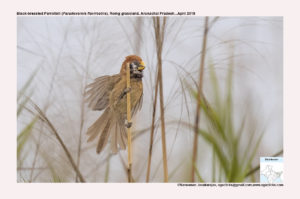
Black-breasted Parrotbill Paradoxornis flavirostris
Etymology:
- Paradoxornis : Greek word paradoxos- extraordinary; ornis- bird
- Flavirostris : Latin word flavus- yellow; rostris-billed
Vernacular Names: Cachar: Dao mougashagadeba, Plains Miris: But-but sorai
Distribution in India: Resident of North East Indian Plains.
Description: Size of 19·5–21 cm. It is chestnut-brown from forehead to nape, the lores and ear-coverts are blackish with variable white mottling below eye, neck side (area behind ear-coverts) are chestnut; upperparts are rufescent brown; flight-feathers and tertials are dark brown with creamy-buff inner fringes, dark rufous outer fringes, outer edges of most primaries are paler and duller towards tips; upperwing-coverts are dark brown, outer fringes similar in colour to upperparts; uppertail is dark brown, outer fringes are brighter. The chin to upper breast are mostly black, variable white mottling on throat; underparts are deep rufescent-buff; iris is deep red or red-brown to olive brown; bill is wax-yellow to bright or deep yellow; legs are slate-coloured to plumbeous grey. Both the sexes are alike. The juvenile is richer rufous above, with duller bill.
Habitat: It is found in tall mixed grassland like wild sugar cane, along riverbanks and seasonally inundated riverbeds; also frequents bamboo and wild cardamom. It is found from plains level to 900 m
Food habits: It eats small invertebrates like earwigs and beetles, and their larvae, seeds and berries. It forages in small parties during non-breeding season. It is fairly shy. Often keeps low down, close to ground, when foraging, but periodically ascends to tops of reed or grass stems (particularly when calling). It obtains food from cracks and crevices in reeds and various grasses; makes loud noises when nibbling at flowers of these plants.
Breeding habits: They breed in Mar–Jul in North East India. The nest a very neat, compact deep cup constructed from fine strips/shreds of bark or coarse grasses and bamboo leaves, bound with cobwebs, lined with fine pieces of grass, bark and occasionally hair. The nest is of a bright, clear yellowish colour, blending perfectly with surroundings placed above ground, fixed to three or four reed stems or in cluster of twigs jutting out from a bamboo node or in a sapling. They lay a clutch of 2–4 eggs.